All year long, we'll be hosting Charcutepalooza, the meat extravaganza masterminded by bloggers Cathy Barrow (our own MrsWheelbarrow) and Kim Foster.
Each month brings a new challenge (e.g. duck prosciutto, salt curing), and a new roundup of the best posts -- which we'll feature on Food52. Charcutepalooza will culminate in a competition offering an amazing grand prize (details here). You can see a list of past challenges here, read the rules here, and see a list of the bloggers who've signed on here.
Read on below for Cathy's breakdown of August's challenge: Binding!
• • • • • • • • •
charcutepalooza august challenge. binding.
by Cathy on July 15, 2011
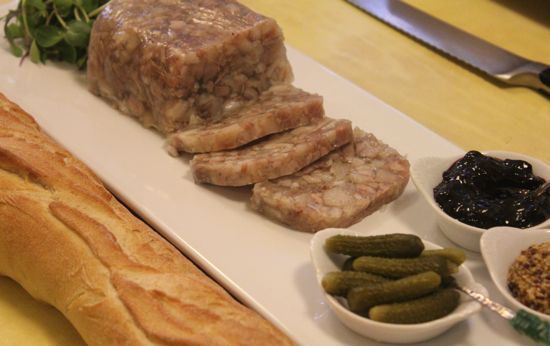
Remarkable sausages have been made in the last three months. Really, you Charcutepalooza folks are making the most amazing foods. And taking gorgeous photos. Makes me want to sit at your dinner tables. Every last one of you.
The Binding challenge will move us away from sausages, and use all those mad charcuterie skills you’ve developed. We’ll be making terrines. Molded, formed, weighted, chilled, sliced, and served cold. And bound with gelatin, egg whites, or natural gel from bone stock.
This month, you have an opportunity to show us what you’ve got. Make the most of the pre-sen-ta-tion (do you hear my French accent? see my arms waving about?)
It’s the perfect month – hot and steamy August – to celebrate chilled charcuterie.
The Apprentice Challenge: Liver Terrine or Fish/Seafood Mousseline
The Charcutiere Challenge: Headcheese, Feet, or Trotters
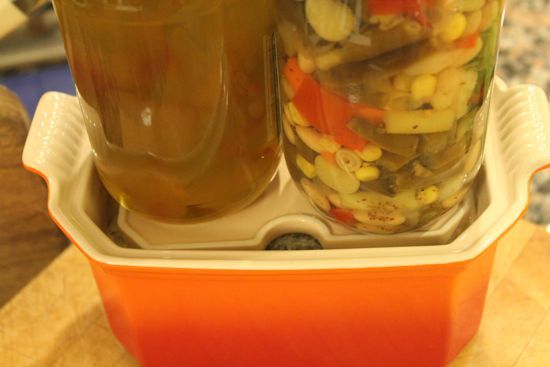
Make it Pretty
We are not making paté. Not yet, anyway. For now, focus your attention on making either a terrine or a mousseline. (I will admit to being a little confused about the difference between terrine and paté – sources are all over the place in their descriptions.) For the challenge, we’re looking for an emulsified texture, bound, and molded.
You might think of swapping out duck or goose liver for chicken liver. Or using lobster or salmon or sole in the seafood terrine. You want a smooth texture and a binding (gelatin or egg white) to help form the mold. You wouldn’t believe all the images of molded food I’ve seen.
It’s all about the texture.
Your experiences with emulsions in the Blending challenge will help you process the protein to the correct texture. The velvety, light mouth feel is exquisite when done properly. Again, there is a possibility of breaking the emulsion, so work quickly and work cold. Have ice baths at the ready to control temperature. Freeze all your equipment – bowls, food processor parts, and especially your mold. Pulse the processor once the mixture is pureed, stopping frequently to test. It should appear silky and shiny, without graininess.
Release, Dammit.
Yes, that’s what Dennis heard me saying. Sort of Shakespearean, don’t you think? For the most spectacular presentation, unmold the terrine. If unmolding makes you a little nervous, don’t worry. Lining the mold in plastic wrap will ensure an easy release. However, it will not be without a few little wrinkles in the surface that will need to be patched or garnished. I found these sweet ceramic terrines at a yard sale and use them all the time.
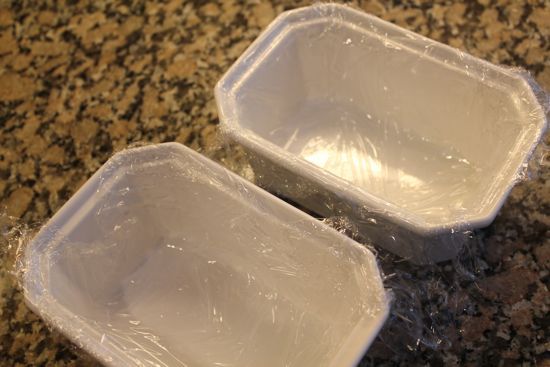
Optionally, pack the mixture in a ramekin, a pretty little bowl, or a decorative jar and serve right from the container. It’s possible to use plastic wrap to form a roll, chill and slice discs to plate and serve.
Read Ruhlman’s fantastic Chapter Six. Best Tip Ever – Moisten the inside of the mold before attempting to press plastic wrap into the corners.
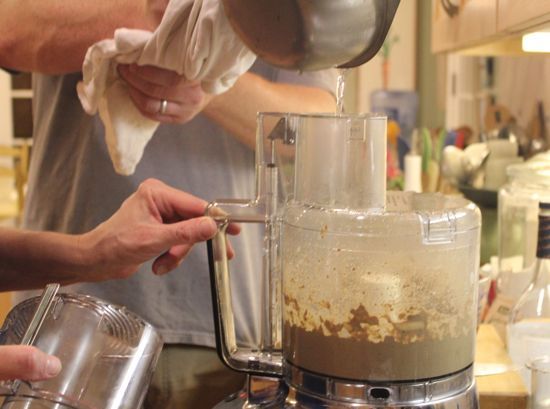
If you’re feeling bold, don’t bother lining the mold with plastic wrap. Chill the terrine well, and when you are ready to serve, loosen the terrine by dipping the bottom of the mold (food side up, obviously) into a sink filled with an inch or two of very hot water, then, flip the whole thing over and unmold onto your very best serving dish. Channel Julia and do it all with a big flourish.
Paul, Elaine and I made both of these terrines, start to finish, in about an hour and a half. It’s not difficult or time-intensive work. The real challenge is in creating beauty. Either with plating, garnishes, molding or, in the best of all worlds, all three.
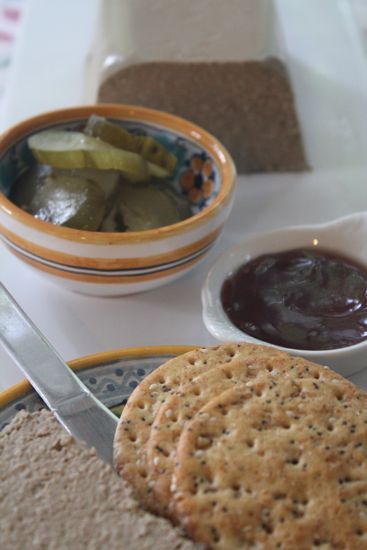
Chicken Liver and Apple Terrine
3 tsp. unflavored gelatin
1/3 cup cold water
8 oz. butter, divided
1 lb. chicken liver
1/2 cup Armagnac
1 Granny Smith apple, peeled, cored and chopped
2 tsp. salt
1 tsp. dry mustard
1/2 tsp freshly ground nutmeg
Finely ground black pepper, to taste
Prepare your terrine mold.
Stir the gelatin into the cold water to soften.
Remove the livers from their package into a strainer over a bowl to capture the juices. Examine each liver, carefully, removing the connecting sinew, and pat dry.
Heat one ounce of butter in a large heavy skillet, not cast iron. (I have no idea why, except that’s what my mother taught me.)
Cook the livers on medium high heat, until very slightly browned with no pink remaining in the center. Add the apples and cook briefly. Put livers and apples into a bowl and place in an ice bath.
Quickly deglaze the pan with 1/4 cup of the Armagnac. Scrape up the the bits and pieces from the bottom of the pan and add everything to the bowl with the livers.
In a double boiler, or a bowl set over a pot of boiling water, melt the gelatin. Add the juices captured from the livers and stir well.
Add the bowl of liver, onions and liquids to the bowl of the food processor. Puree to a very very smooth consistency. No lumps.
Add the gelatin mixture and remaining ingredients. Continue to process until the texture suits you.
Pour the mixture into a bowl over an ice bath and cool until just barely warm.
Whisk in the remaining butter, a tablespoon at a time.
Taste and correct for salt and pepper. Keep in mind, foods served cold benefit from a little extra salt.
Pour the mixture into the frozen mold. Fold the extra plastic wrap across the surface of the terrine. Cover with a piece of parchment, and add a small weight. I used a two half pint jars of jam.
Refrigerate several hours until very cold and jelled. Take the terrine out of the refrigerator and unmold, to take off the chill before serving.
Serve with garnishes – something acidic and something sweet. I offered my homemade champagne grape jelly and sweet pickles.
Seafood Mousseline
Many many many years ago, I owned a small fish market called Porgy and Bass. We offered both fresh and prepared fish, and one of the regular dishes was a layered fish terrine, sold by the slice. One layer was sole and one was salmon, with a spinach and leek mousseline in the center. When sliced, it was pink and green and white, flecked with herbs. This was a very 80’s appetizer and making Charcuterie’s Maryland Crab, Scallop, and Saffron Terrine was like time travel. A million taste memories.
I had forgotten just how much I love a mousseline. And my dinner guests were wowed. This is a delicious summer appetizer, bright, airy, meltingly good. I served it with homemade mayonnaise mixed with yogurt and spiked with a little smoked paprika. Thank you so much, Michael Ruhlman. (And let me say – so thrilled to see Salumi is due June, 2012! Salumipalooza, anyone?)
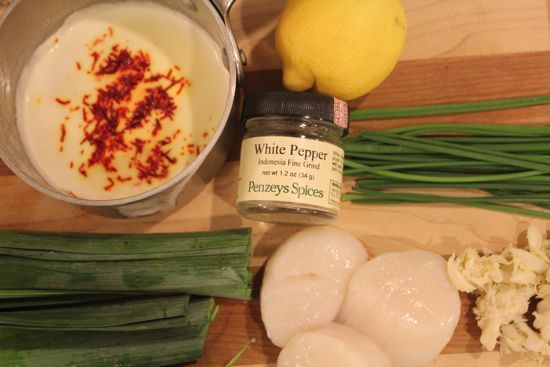
Use very fresh scallops. They should fill the kitchen with the briny scent of the sea as soon as you start the food processor. Keep everything cold. I used backfin crabmeat and I wish I had used lump crabmeat. I wanted to find little jewels of crabmeat, rather than having the crab distributed evenly throughout the terrine. (By the way, perplexed to see the crab at the grocery store was from Louisianna, Thailand, Chile and Texas. Mixed in? One lone container from Maryland.)We divided this recipe in half and it fit beautifully in a small Le Creuset terrine mold.
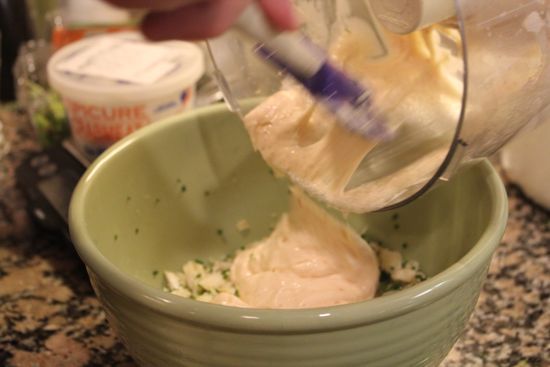
 We divided this recipe in half and it fit beautifully in a small Le Creuset terrine mold. The terrine is cooked in a bain-marie and, in a 300° oven, took 45 minutes to reach an internal temperature of 150°. Once cooked, I weighted the mold with two jars of jam, and chilled it for a day before serving. It held for five days.
We divided this recipe in half and it fit beautifully in a small Le Creuset terrine mold. The terrine is cooked in a bain-marie and, in a 300° oven, took 45 minutes to reach an internal temperature of 150°. Once cooked, I weighted the mold with two jars of jam, and chilled it for a day before serving. It held for five days.
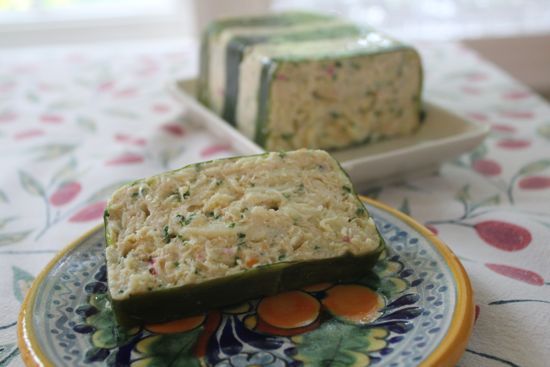
What do you call head cheese made with pig feet?
I’ve been worrying about this for days. Clearly, I’ve made toe cheese.
When I visited with Bob delGrosso, he asked if I wanted some pig feet. I gladly accepted two fine specimens, promptly put them in the freezer and wondered what to do with them. I knew this challenge was coming, but assumed I would have to get a pig head.
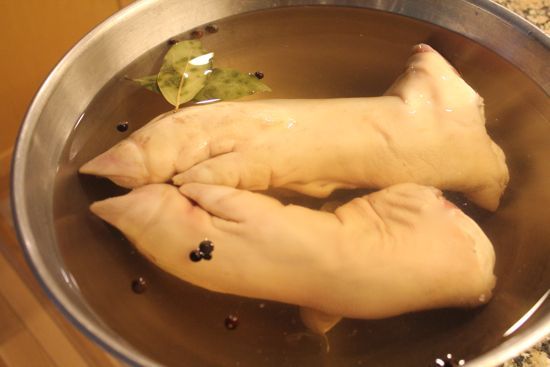
I love Charcutepalooza, I really do, but I just wasn’t that into the pig head. It’s not that I’m squeamish, it’s just makes quite a bit of headcheese. And Dennis? So not into the idea of a pig head floating in a big bowl in the fridge. That’s how I got the idea to make some toe cheese.
The flavors were inspired by a conversation with Chef Collin Donnelly doing amazing artful cooking for the slamming menu at The Red Hen in Lexington, Virginia. At Kate Hill and Dominique Chopolard’s butchery workshop in Virginia, Collin was kind enough to bring a few samples of his work – paté, sausages and other treats – that wowed every one of the attendees. I’ve been planning to run away to Lexington ever since.
Collin called me a few days after the workshop to tell me about a headcheese salad he had just put on the menu. He described aromatics – star anise, juniper, allspice, clove and cinnamon – and a technique (spreading the chopped meat across a sheet pan, pouring the gelatin based liquid over it, and placing another sheet pan over the top, to make perfect even one inch sheet. He had used feet and added a shank for extra meatiness. The headcheese was presented cubed and served as part of a salad. Every word he said got me revved up for head – or toe – cheese.
I brined the two feet for 24 hours, adding aromatics to the salty water. Then I simmered the rinsed feet for about 4 hours, repeating the aromatics, until everything was exceptionally tender.
The feet do not have much meat, and I wish I had added a shank, but the skin was supple and delicious after scraping away the fat and chopping into very small pieces. The tendons had softened and had great texture. And with diligent work, there was meat to be had. It’s important to use your fingers to separate all the parts and pieces. You will feel the difference between something you want to eat and something you really don’t. Trust me.

The broth was very jiggly, with a lot of natural gelatins. I used a frozen plate to test for gel, just as you do with preserves. It was amazing, rich and porky. I was certain of a good set.
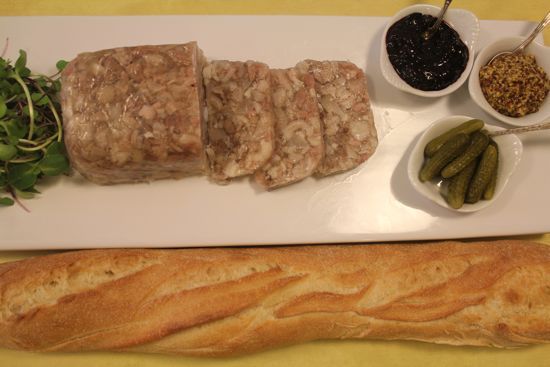
Into the frozen, lined terrine went all the meat, shredded and minced, different sizes. The broth was poured in, filling the mold. Fold the overlapped plastic wrap to seal. Chill, weighted, overnight.
This toecheese was very good indeed, and perfectly accompanied by grainy mustard and a black currant preserves inspired by a currant-reduced-to-wine, saucy taste at Jenny’s house, albeit in an entirely different context.
You have a broad challenge, Charcutieres. Knock our socks off – let’s see something made with the head, or the feet, or the trotters.
Charcutepalooza loves our sponsors. D’Artagnan , generously offering 25% off the meat-of-the-month. If you aren’t receiving your email with the secret code for Charcutepalooza members, register here. And the trip to France – an awesome grand prize deliciously designed by Trufflepig and Kate Hill at Camont. Love to Kinetic Web Solutions and @CreativCulinary who helps us navigate technology. And, Armagnac CASTAREDE, providing celebratory Armagnac to our Grand Prize winner’s party in Paris.
Tagged as: chicken liver, duck liver, goose liver, headcheese, liver mousse, liver terrine, pigs feet, seafood mousseline, seafood terrine, the red hen













See what other Food52 readers are saying.